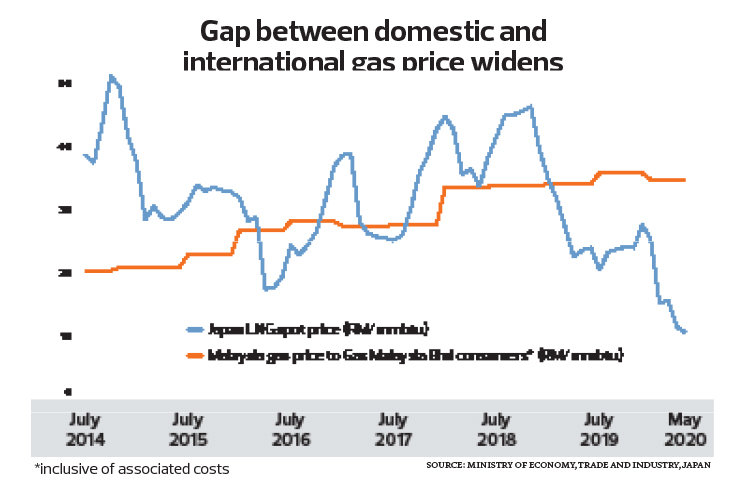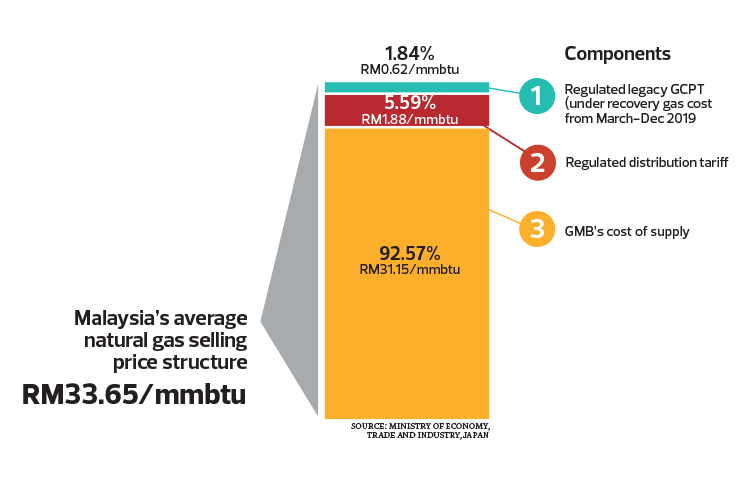Cover Story: International gas prices crash, but local price stays
IN March and April, Malaysians paid very low prices for petrol due to the epic crash in oil price as the Covid-19 pandemic stalled economic activities.
However, we are still paying a hefty sum for another fuel, natural gas, even though the international price of liquefied natural gas (LNG) crashed to record lows last month.
In short, the price gap between the domestic and international prices has been reversed as the local price had been substantially lower in the past.
Under the newly introduced third party access (TPA) regime that took effect in January, natural gas prices should be dictated by international price movements.
For some reason, the Energy Commission (EC) imposed yet another fixed pricing structure, effective for the whole of 2020, before another review was scheduled.
The fixed structure fails to address the recent decline in market prices, resulting in a mismatch whereby Malaysians appear to be overpaying for a fuel used for power generation and the glove manufacturing and steel industries.
How much should Malaysians be paying for natural gas?
In December 2019, Gas Malaysia Bhd announced the EC-approved average selling price of RM33.65 per million British thermal units (mmbtu) for natural gas, which was RM1.01 or 2.91% lower than the rate in the second half of that year.
Working backwards, the selling price includes the regulated distribution tariff to Gas Malaysia (RM1.88) and regulated legacy gas cost pass-through (RM0.62).
The remainder comprises the bundled cost of supply (RM31.15), which goes to Petronas, the gas supplier. This includes the cost of gas and other associated costs of transport via pipeline. If the natural gas is imported in LNG form, other associated costs, such as shipping and regasification, will be incurred.
A ballpark figure for the associated costs is estimated at around RM6 to RM7/mmbtu, leaving the estimated cost of gas at around RM24 to RM25/mmbtu.
The 2020 pricing structure was announced before the coronavirus outbreak came into the picture. Asian spot LNG then hovered at around US$6.40 (RM27.33)/mmbtu. (US$1 = RM4.27).
However, the spot price plunged to below US$3 (RM12.81)/mmbtu in April and May — half of what Malaysians are estimated to be paying.
Even if spot LNG trades at the consensus fair value of US$4.50 (RM19.22), there is still an excess payment of around RM5 to RM6/mmbtu by Malaysian consumers. This is absorbed by Petronas at the expense of the country’s non-power gas consumers.
Of course, if LNG prices shoot up, Petronas will have to bear the cost difference, in line with the pricing structure. In the past, Petronas had absorbed the lower regulated piped gas price as forgone revenue.
While the natural gas price is fixed for non-power consumers this year, it has been revised downwards for independent power producers (IPPs) to about RM26/mmbtu, industry sources say. These cost savings will be passed on to consumers under the imbalance cost pass-through mechanism, meaning lower electricity tariffs.
A fixed selling price is in conflict with the purpose of the TPA regime, which is to allow market forces to dictate prices.
It is inevitable that the EC will revise non-power prices downwards to reflect market conditions soon. It could switch back to a bi-annual review to allow more leeway for fuel price adjustment, instead of the yearly adjustments introduced this year.
Better still, it can allow a free float of gas prices so that both consumers and gas suppliers will not be shortchanged, while setting tariffs for regasification, transport and distribution.
The commission did not immediately respond to queries from The Edge.
Low gas price boon for businesses
If market forces are allowed to dictate prices, the current low price environment will be a boon for manufacturers such as steelmakers, petrochemical producers and, in particular, glove makers — the new investor darling as a result of the pandemic and the biggest non-power consumers of natural gas.
Natural gas is estimated to make up 10% to 15% of the operating costs of glove makers as at last year, analysts say.
Low input costs will result in fatter margins — average selling price and sales volume have already seen an increase as the demand for gloves outstrips supply because of the pandemic.
When contacted, the Malaysian Rubber Gloves Manufacturers Association said it expects prices to trend lower moving forward.
“Gas Malaysia, in line with the very soft demand for natural gas and falling international prices, has done the rightful thing in revising the gas prices downwards [for 2020],” it said in a written reply.
“The glove industry is aware that further reduction is inevitable, as the gas price could end up at zero value,” it said, referring to the crash in the West Texas Intermediate price in April owing to dwindling storage capacity even as demand plunged.
A similar situation could unfold for gas, which is tougher to store as it needs to undergo energy-intensive processes like refrigeration.
“However, it must be said that as long as Gas Malaysia is fair and capable of providing good and efficient services to the industry, the thought of procuring our own gas will be held in abeyance,” the association added.
“Thus far, both Petronas and Gas Malaysia have been fair, and obviously we can still accommodate each other.”
Long way towards liberalisation of gas supply
There are currently two regasification terminals in Peninsular Malaysia that enable any manufacturer or prospective player to import LNG.
Unfortunately, taking advantage of the current low international price is not that simple for business owners.
To get economies of scale, a new supplier must procure a sizeable gas supply, but there is currently no sizeable new demand to cater to.
Existing demand has been locked in by Gas Malaysia, which signed new take-or-pay contracts with its consumers last year for a three-year period ending 2022.
As things stand, with the anticipated lower-for-longer price environment in the oil and gas space, consumers can only count on the EC and keep their fingers crossed that the commission will take into consideration the current economic situation and international market price.
The content is a snapshot from Publisher. Refer to the original content for accurate info. Contact us for any changes.
Related Stocks
| GASMSIA | 3.530 |
Comments

